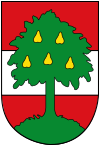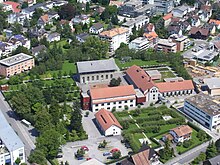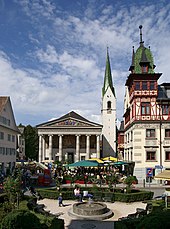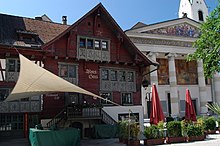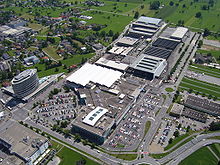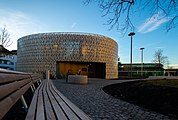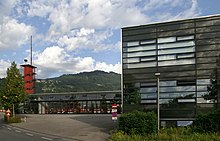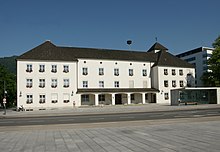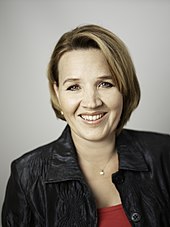Dornbirn
|
Borough Dornbirn
|
||
|---|---|---|
| coat of arms | Austria map | |
|
|
||
| Basic data | ||
| Country: | Austria | |
| State : | Vorarlberg | |
| Political District : | Dornbirn | |
| License plate : | DO | |
| Surface: | 120.83 km² | |
| Coordinates : | 47 ° 25 ' N , 9 ° 45' E | |
| Height : | 437 m above sea level A. | |
| Residents : | 49,872 (January 1, 2020) | |
| Population density : | 413 inhabitants per km² | |
| Postal code : | 6850 | |
| Area code : | 05572 | |
| Community code : | 8 03 01 | |
| NUTS region | AT342 | |
| UN / LOCODE | AT DOR | |
| Address of the municipal administration: |
Rathausplatz 2 6850 Dornbirn |
|
| Website: | ||
| politics | ||
| Mayoress : | Andrea Kaufmann ( ÖVP ) | |
|
Local council : (2015) (36 members) |
||
| Location of Dornbirn in the Dornbirn district | ||
 View from the cart to the city of Dornbirn |
||
| Source: Municipal data from Statistics Austria | ||
Dornbirn ( , local Vorarlbergerisch : [ ˈdo: rəˈbi: rə ]) is the most populous municipality in the Austrian state of Vorarlberg and at the same time the seat of the Dornbirn district administration . The city is an economic center in the north of the westernmost state of Austria and a regional transport hub. With its 49,872 inhabitants (as of January 1, 2020) Dornbirn is the tenth largest city in Austria and the largest without its own statute .
The importance of the city only developed relatively late at the end of the 19th century with the flourishing of the textile industry, which quickly made Dornbirn the largest municipality between the Alpine Rhine and Arlberg . Since the decline of the local textile industry in the last quarter of the 20th century, trade, commerce, tourism and some medium-sized industrial companies have dominated the city's economy, which is still a dominant economic center of Vorarlberg and by far the largest place of work in the state. In addition, Dornbirn, with the Vorarlberg University of Applied Sciences established here since the 1990s, is the most important university location in the state and a center for science and education.
geography
Geographical location
Dornbirn is located at an altitude of 437 meters in the Rhine Valley at the foot of the Bregenz Forest Mountains and thus on the western edge of the Eastern Alps . Geographically, Dornbirn belongs to the Vorderer Bregenz Forest, which is part of the Austrian Pre-Alps. By far the most important river is the Dornbirner Ach , which divides the local area into two halves and thus also forms the border of some city districts .
geology
Most of the Dornbirn settlement area lies directly on the sediment fan of the Dornbirner Ach. Due to its location in the Rhine Valley, the community is geologically located in the so-called Lake Constance basin, which was partly tectonically created, but was also formed by the erosion of the Rhine glacier, which receded after the last ice age. The Lake Constance basin forms the subsoil on which the sediments washed up by the Dornbirn Ach could be deposited and thus determine the current subsoil of Dornbirn. In the east of the municipality rise the first mountains of the Eastern Alps, which here for the most part still consist of brittle diluvial masses.
Altitude
The general altitude of the city of Dornbirn is 437 m above sea level. A. stated. This corresponds to the position of the stone city coat of arms, which is embedded in the middle of the market square. The geographically lowest point of Dornbirn is the river bed of the Dornbirner Ach a few meters before the confluence of the Vorarlberg Rhine Valley Inland Canal in the extreme north of the municipality at 399 m above sea level. A. The highest point is the summit of the Sünserspitze at 2061 m above sea level. A.
City structure
| # | district | Residents | location |
|---|---|---|---|
| 1. | market | 13,706 | center |
| 2. | Hatlerdorf | 11,161 | south |
| 3. | Oberdorf | 5,000 | east |
| 4th | Hazel trees | 5,409 | north |
| 5. | Rohrbach | 7,755 | west |
| 6th | Shear | 5,638 | west |
| Population as of 2012 | |||
Dornbirn did not grow together from formerly independent villages , but was always a single municipality , the settlement areas of which, however, were very scattered and with today's districts 1 to 4 consisted of four unconnected parts. At that time these “quarters” were still called Niederdorf, Hatlerdorf, Oberdorf and Stiglingen . It was not until 1902 that these four districts were officially declared urban districts with their current names (Niederdorf became the Markt district, Stiglingen became Haselstauden). Today there is an urban area that has grown together, which expanded particularly to the west of the railway line in the second half of the 20th century. In these areas, the Rohrbach and Schoren districts were partially created, which only became separate city districts in 1994.
Districts
The city's population is mainly concentrated in the core area in the extreme northwest of the municipality. However, there are still numerous smaller places known as mountain parcels , especially on the mountain slopes in the east of the city . These include Watzenegg and Kehlegg , which have high land prices , especially because of their hillside location and the view of the Rhine Valley. In addition, Winsau , Heilgereuthe and numerous other collections of houses in the eastern mountain area also belong to the city of Dornbirn. The most outstanding parcel of Dornbirn is the Walser village of Ebnit , which was formerly an independent municipality and became part of the city in 1932 due to financial problems. The Ebnit is also the southernmost and easternmost year-round inhabited area of Dornbirn and thus forms the center of the south-eastern municipality area, which is characterized by mountains and forests.
Neighboring communities
Due to the size of the municipality of Dornbirn, the city has numerous borders with other municipalities. Of the 15 neighboring communities in Dornbirn, nine belong to the political district of Bregenz ( Lauterach , Wolfurt , Schwarzach , Bildstein , Alberschwende , Schwarzenberg , Reuthe , Mellau and Damüls ) and four to the Feldkirch district ( Laterns , Zwischenwasser , Viktorsberg and Fraxern ). In addition, the two other municipalities of the Dornbirn district ( Hohenems and Lustenau ) border the municipal area of the city, which is the only municipality in the district that does not have a state border as a municipal boundary . (The municipalities are given clockwise, starting in the north.)
Area balance
The entire Dornbirn municipal area extends over an area of around 121 square kilometers (12,093 hectares ), the area is spread over three cadastral communities
- Dornbirn (9,930.41 ha)
- Ebnit I (1,159.09 ha)
- Ebnit II (1,003.50 ha)
Of this total area, around 4,815 hectares are forest areas and 5,723 hectares are meadows, pastures and the Alps. The municipality of the city of Dornbirn makes up about 70% of the area of the Dornbirn district (172.27 square kilometers). Dornbirn is the third largest municipality in Vorarlberg after Gaschurn and St. Gallenkirch and makes up 4.65% of the total area of the state.
Mountain landscape
Due to its location on the edge of the Eastern Alps and the Bregenz Forest Mountains, the city of Dornbirn can reach several mountain peaks over 1,500 resp. Mention an altitude of 2,000 meters in their municipality. The most striking are the 971 meter high Karren , which is accessed by a cable car and is Dornbirn's local mountain , and the Staufen ( 1465 m above sea level ). The 1,830 meter high Mörzelspitze and the Hohe Freschen, which is 2,004 meters high, are also popular with hikers . The highest mountain in the municipality is the rather inconspicuous Sünserspitze at 2062 m above sea level. A. Most of the mountain peaks in the municipality are accessible by hiking trails. The mountain landscape of Dornbirn is determined by the so-called First , the mountain range to which the Mörzelspitze, Hohe Freschen and Sünser Spitze belong and which can still be seen from Friedrichshafen on a clear day .
Rivers and bodies of water
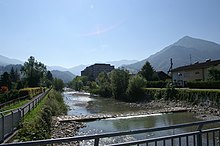
The waterway map of the municipality is dominated by the Dornbirner Ach , the main river of Dornbirn. The Ach is one of the most important drainage rivers in the front Bregenzerwald and also drains for numerous larger and smaller streams in the Dornbirn mountain landscape. Most of the countless rivers and streams that join the Dornbirner Ach during its course from the southernmost to the northernmost point of the municipality have no name. The Fallbach is the only stream that does not flow directly into the Dornbirner Ach, but first flows into the Rhine Valley inland canal . There are only a few lakes in Dornbirn, two of the best known are the Sünser See and the Staufensee reservoir . In its course, the Dornbirner Ach also flows through the Alploch and Rappenloch gorges , two millennia-old gorges that are nowadays developed and accessible for tourists.
climate
The climate in Dornbirn is relatively mild by Austrian standards, favored by its location in the Rhine Valley and the foehn . The average temperature over the entire year is 10 ° C.
The warmest month is July with an average of 19.3 ° C, the coldest is January with 0.4 ° C. Permafrost periods occur almost annually, but extreme lows are rare. The average low temperature over the course of the year is −13.0 ° C. Like the entire Alpine Rhine Valley, Dornbirn lies on the border of USDA climate zone 7b to 8a and is one of Austria's mildest regions in winter.
The frost-free period lasts on average from mid-April to the end of October. Temperatures do not drop below freezing between the beginning of May and the end of September.
The lowest recorded temperature since measurements began in 1993 is −17.9 ° C, the highest so far at 36.8 ° C.
Noteworthy is the extensive annual precipitation for Central European conditions , which is a long-term average a little over 1,500 mm and in parts of the municipal area increases to well over 2,000 mm. As a result, closed, sometimes considerable, snow covers are registered in all winters.
In winter, the sun shines on average between two and four hours a day. This number increases to over seven hours by the summer months of June to August. The average duration of sunshine is just under 1,800 hours a year, which is relatively little for the conditions in Austrian valleys.
| Dornbirn | ||||||||||||||||||||||||||||||||||||||||||||||||
|---|---|---|---|---|---|---|---|---|---|---|---|---|---|---|---|---|---|---|---|---|---|---|---|---|---|---|---|---|---|---|---|---|---|---|---|---|---|---|---|---|---|---|---|---|---|---|---|---|
| Climate diagram | ||||||||||||||||||||||||||||||||||||||||||||||||
| ||||||||||||||||||||||||||||||||||||||||||||||||
|
Monthly average temperatures and precipitation for Dornbirn (1993-2018)
Source: ZAMG yearbook
|
||||||||||||||||||||||||||||||||||||||||||||||||||||||||||||||||||||||||||||||||||||||||||||||||||||||||||||||||||||||||||||||||||||||||||||||||||||||
population
|
Population development

|
Population structure
Dornbirn has a current total population of 49,872 people (January 1, 2020) - that is about 12% of Vorarlberg's residents.
The city's population is almost equally divided into men and women. While the census in 2001 counted 20,730 men (49.0%), the female part of the population came to 21,571 (51.0%). In the same census, it was found that 86.6% of the residents of Dornbirn are Austrian citizens . For the Roman Catholic Church to 74.8% of the Dornbirn-known (in the whole of Vorarlberg 78.03%), a further 2.6% were Protestant creed (Vorarlberg 2.23%), and 2.7% belonged to a Christian Orthodox Church on (Vorarlberg 2.61%). The second largest religious group was that of Islam . In 2001, 9.9% of the residents of Dornbirn were Muslim (Vorarlberg 8.36%), only 8 citizens were of Jewish faith .
The largest age group in this census was the 35 to 39 year olds with 8.4%. Nevertheless, the average age of the total population in Dornbirn is slightly higher than that of the federal state. 18.5% (in all of Vorarlberg 19.73%) of the population were under 15 years old at the time of the survey, 63.3% (Vorarlberg 63.16%) were between 15 and 60 years, and 18.2% (Vorarlberg 17, 29%) were over 60 years old. Around 44.1% of Dornbirn residents were single in 2001, another 7.0% divorced . In contrast, 43.4% were married and 5.5% widowed .
Migration and integration
Dornbirn is strongly influenced by immigration : it is the city in Vorarlberg with the highest proportion of foreigners, which is characteristic of the entire district. In 2001, 1.7% of the people living in Dornbirn were citizens of another EU country and 11.7% were citizens of a country outside the EU (however before the EU was enlarged to the east ).
By far the largest proportion of the foreign population is of Turkish origin, as in most of the other cities in Vorarlberg . 3,484 people gave Turkish as the colloquial language , and 4,206 people professed their Muslim faith.
In contrast, there are 35,411 people who speak German as their mother tongue, 35,667 people who were born in Austria and 39,812 Austrian citizens (in 2006). This fact results from the great waves of immigration in the 1950s and 1960s, when, with the renewed flourishing of the textile industry, more and more workers from Turkey were recruited as guest workers . Many of these former textile workers now live with their families in Vorarlberg, younger generations were born in Austria and grew up in western culture.
Because of this, the city of Dornbirn commissioned an intercultural model in autumn 2001, which was presented to the public in November 2002 with the help of the ethnological seminar of the University of Basel and the base office for applied social research and development .
history
Prehistory and early history
The earliest evidence of human presence in today's Dornbirn municipality can be dated to the Middle Stone Age (8000 to 3000 BC). These include a disc-shaped club head made of green-black quartzite found in 1971 under the Achmühl bridge. The first finds in urban areas that are still inhabited today can be assigned to the Bronze Age (3000 to 1800 BC). Coins from the 2nd century from Rosenstrasse and a fibula from the 1st century found in the Köblern corridor provide evidence of a Roman presence in the city of Dornbirn. The first evidence of a settlement in the area of today's Dornbirn is an Alemannic skeleton grave with saxophone and knife as additions from the 6th and 7th centuries. This suggests a settlement in the area of today's Hatlerdorf district.
middle Ages
For the first time, the settlement of Torrinpuirron - translated as "The Courts of Torro" - is mentioned in a memo of a St. Gall document issued on October 15, 895 . Accordingly, the St. Gallen monastery also held state rule over the area in the following decades. In the Franconian Empire, the young settlement was in the Reichsgau Ringowe and thus under the influence of the Counts of Bregenz .
In the following decades ownership changed first to the Bregenz line of the Counts of Montfort , then to their Feldkirch line. Eventually these were incorporated into the Habsburg Empire , making Dornbirn Austrian in 1380. In 1391 it was mentioned in a document as Veste Dorrenburren , which probably meant the Oberdorfer Tower. In the immediate vicinity of the location of the now defunct Oberdorfer Tower is the Schlossguggerhaus , which, with its approximate construction date around 1294, is the oldest surviving building in Dornbirn.
At the end of the 14th century, the Counts of Ems succeeded in acquiring some important properties in Dornbirn's municipality. As early as the middle of the 15th century, large parts of Dornbirn were in Emser hands (1575 to 1759).
Modern times
In 1654 Archduke Ferdinand Karl sold the Dornbirn court to the Counts of Ems. The people of Dornbirn put up bitter resistance and even refused to pay homage to the new sovereign. With the help of the state estates, the people of Dornbirn managed to raise 4,000 guilders for the repurchase of the jurisdiction, whereupon the Archduke withdrew the sale and rewarded Dornbirn for its loyalty to the Habsburg dynasty with the court coat of arms, which is still in use today (see section Coat of Arms ). In 1771, due to the high indebtedness of the Emser, the population finally managed to buy all the land that they owned in Dornbirn. This significant event in the history of the city is known today as the ransom of Ems . In 1793 Dornbirn was raised to the status of a market town, fell to Bavaria in 1805 as a result of the peace treaty from Pressburg to the Illerkreis with Kempten as the capital, and came back to Austria in 1814. The end of the 18th and the beginning of the 19th century brought a brisk economic upswing, in particular due to the construction of the railway line.
20th and 21st centuries
With a resolution of November 21, 1901, Emperor Franz Joseph I elevated Dornbirn to the status of a city, which was extensively celebrated on site in the following days. This made Dornbirn the fourth city in the state of Vorarlberg (82 years later Hohenems was added as the fifth and so far last city). The year before, during a visit to Dornbirn at the FM Hämmerle textile factory, the emperor had put the Austro-Hungarian monarchy's first outside telephone system into operation. In 1902, the Dornbirn – Lustenau Electric Railway (EBDL), a tram between the two communities, was inaugurated.
In the First World War (1914–1918) 596 residents of the young city were killed as soldiers. In the interwar period, Dornbirn was spared any civil war unrest, as a large part of the Dornbirn population committed to the Austro-Fascist corporate state . In 1932, the independent community Ebnit , which was heavily indebted due to the construction of Ebniterstraße, was incorporated into the city of Dornbirn.
Even before the annexation to the German Reich in 1938, Dornbirn was considered a “brown nest” in Vorarlberg and a stronghold of the National Socialists . It was also the scene of the few sensational bomb attacks by the National Socialists, who were still illegally operating in Vorarlberg at the time.
On March 12, 1938, following the abdication of Chancellor Kurt Schuschnigg, the day before, troops of the German armed forces marched into Dornbirn and carried out the " Anschluss of Austria ". Anton Plankensteiner from Dornbirn was appointed the new district leader, and Governor Ernst Winsauer was relieved of his office. As early as the spring of 1939, Dornbirn was declared Vorarlberg's first “Jew-free city”. During the time of National Socialism, Dornbirn was, alongside Bregenz and Bludenz, one of the three Vorarlberg district towns in the " Reichsgau Tirol-Vorarlberg ".
During the Second World War , a total of 5,789 men from Dornbirn did military service, 709 of them died. Other sources speak of 837 or more than 1,000 fallen and missing, which would correspond to about 5.8% of the resident population of 1939.
On May 2, 1945, the city was taken almost without a fight by the 1st French Army . At 9:30 p.m., the radio station in Dornbirn gave the historical words: “This is the Austrian radio, broadcasting station Vorarlberg in Dornbirn. We are the first Austrian broadcasting station to start the service. " In occupied post-war Austria , Dornbirn belonged to the French zone like all of Vorarlberg until the end of the occupation in 1955.
The economic upswing in Vorarlberg that followed after the liberation of Austria was made clear by the first sample show in Dornbirn (later the Dornbirn trade fair ) in 1949. In 1969 Dornbirn became the seat of the district administration of the newly created district of Dornbirn, which had split off from the Feldkirch district. The city was able to successfully bring the regional structural change that had occurred since the 1970s due to the decline of the local textile industry . Due to the construction of a new city street in 1987, the city center of Dornbirn was set up as a pedestrian zone in the following year . In 1991, Vorarlberg's first city bus was set up in Dornbirn as a pioneering project for local public transport. The Dornbirn city bus quickly developed into a pilot project for many other cities and communities. With the Vorarlberg University of Applied Sciences , the first university with the character of a university in the state was founded in 1994 and settled in Dornbirn.
In 2001 the city celebrated the 100th anniversary of its town elevation. In 2007 the 13th World Gymnaestrada , a major sports event with around 22,000 participants, took place in Dornbirn. In order to improve the transport infrastructure, the city street, the main artery in the inner city area, was completely renovated and renewed in 2008 and 2009, with a new inner city underground car park being built in the area between the cultural center and town hall directly under the street. In 2019 the World Gymnaestrada took place again in Dornbirn with more than 19,000 participants. On February 5, 2020 it was officially announced that the city would have more than 50,000 inhabitants for the first time.
Culture and sights
Several cultural venues can be found in the trade fair city of Dornbirn. The Kulturhaus Dornbirn offers space for various theater and cabaret performances , as well as for other occasions. The Spielboden , a stage for Vorarlberg artists, and the Conrad Sohm are also known beyond regional borders .
"Dornbirn Klassik" organizes classical concerts all year round.
As a relatively young city (city census only in 1901), Dornbirn has only a few landmarks or tourist destinations. The municipality of Dornbirns offers a multitude of interesting occurrences, especially in the natural area.
In February 2018, the city of Dornbirn announced that it would apply as a banner city together with the cities of Feldkirch, Hohenems and the Bregenzerwald region for the title of " European Capital of Culture " 2024. Originally, the city of Bregenz wanted to enter the race as a banner city for this application community, but withdrew from the application at the end of 2017. Those responsible then agreed on Dornbirn as the banner city. In the run-up to the official application, numerous dialogue and thought workshops took place in several municipalities and cities throughout Vorarlberg. The application process was led by cultural manager Bettina Steindl. The application office “Kultur Perspektiven 2024” was founded in 2018 for the application and was renamed “Dornbirn plus Feldkirch Hohenems Bregenzerwald” - “Dornbirn plus” for short after the official application was submitted. On January 31, a twelve-person jury announced that Dornbirn had been placed on the so-called shortlist and had thus advanced one round in the selection process. This also applied to the other two applicants from Austria, St. Pölten and Bad Ischl . Ultimately, however, Bad Ischl prevailed against St. Pölten and Dornbirn in the jury's decision in November 2019 and thus became the cultural capital of 2024.
Museums
In addition to the municipal facilities, the city museum / city archive, the inatura Erlebnis Naturschau Dornbirn , an interactive museum on natural history and natural history known beyond regional borders, on the former premises of the Rüsch-Werke in the middle of the new city park, has been added to the city's facilities . The Kunstraum Dornbirn , the Nativity Museum in Dornbirn and the Rolls-Royce Museum are also among the city's well-known museums.
In July 2009, a museum for the Munich-based sculptor Wolfgang Flatz , who was born in Dornbirn, opened in the converted building of the former Vorarlberg Nature Show . The museum, which consists of only two rooms, is entirely dedicated to the work of the artist known for his provocative actions.
architecture
The young townscape of Dornbirn is shaped by the architectural style of the 19th and 20th centuries. In the second half of the 20th century, the local architecture scene attracted international attention under the name Neue Vorarlberger Bauschule , whose representatives include the Cooperative Dornbirn - later Baumschlager & Eberle , Dietrich / Untertrifaller and Oskar Leo Kaufmann. In and around Dornbirn, especially since the 1980s, many buildings have been built that have received European attention under this label.
Older buildings in Dornbirn are also architecturally interesting. On the one hand, these are located directly on the market square, with the symbol of Dornbirn, the “Red House” and the St. Martins Church. Other historically significant or architecturally interesting buildings are the parish churches of the other city districts and districts.
- Historic buildings
-
Stadtpfarrkirche St. Martin (1839–1840)
This church is popularly known as the Dorfer or Markterkirche . The St. Martins Church is first mentioned in 1130. The church in its current form represents at least the fifth building in almost the same place. The currently existing church building was built by state master builder Martin Ritter von Kink between 1839 and 1840 and represents a blend of classicism and historicism. The local artist Josef Huber In 1923 created the fresco “The Four Last Things” on the entrance wall and the following year the mosaic “Entry into Jerusalem” in the flat gable. It is a building with a round apse and a free-standing east tower with a pointed gable roof. -
Red House (1639)
On the site of the former Dornbirn vicarage, Michael Danner and Verena Rhomberg built the Gasthof Zum Engel in 1639 . In 1954/1955 the descendant of the builders, August Rhomberg, had it renovated by the architect Franz Hoffenscher. - Other Rhine Valley houses such as the Loackerhaus, the house at Klostergasse 1 , the houses in the historic center of Hatlerdorf or on the Häfenberg .
- Adolf-Rhomberg-Haus : stately late-baroque town house (1799), which was rebuilt in 1900 with Art Nouveau elements
-
Johann-Luger-Haus (1901–1902)
This conversion by the later Art Nouveau architects shows how closely Art Nouveau and national romanticism were connected in Vorarlberg. - Workers' terraced houses (1907)
These buildings in Bündtlittenstrasse by the Bregenz master builder Otto Mallaun are a special example of the adoption and local application of an English terraced house model. Since there are two apartments on top of each other, they are not real terraced houses, but rather terraced apartment buildings.
- Modern architecture
- Church of Maria, Queen of Peace in Watzenegg (1985–1986)
This building by Wolfgang Ritsch, Siegfried Wäger and Rudolf Wäger can be seen as the prototype of Vorarlberg timber construction from the 1980s. -
Panorama house
In this building by the architect Bernhardügelmayer , the elliptical structure is encased by a curved glass facade. This offers the guests of the Home of Balance and the Four Points by Sheraton the panoramic situation over the landscape of Lake Constance, over the Dornbirn local mountains, the city of Dornbirn, over the Rhine Valley to the Swiss rock massifs as a spatial experience.
nature
The 976 meter high Karren is Dornbirn's local mountain, southeast of the city. The Karrenseilbahn , a cable car that overcomes an altitude difference of around 520 meters, leads up to it. On the wooded summit there is a panorama restaurant and the “Karren-Kante”, a panorama viewing platform that juts out 12 meters above the edge of the rock. From the mountain station you can climb the summit of the Staufen or descend along an educational forest trail to the Staufensee.
There are numerous other mountains in the municipal area of the city, which are easily accessible thanks to the Vorarlberg hiking trail system. The best known are the aforementioned Staufen, the Mörzelspitze and the most striking mountain in the municipality, the Hohe Freschen . The highest mountain is the Sünserspitze .
The Rappenloch Gorge with Staufensee and Alploch is a popular excursion destination southeast of Dornbirn. Both gorges are traversed by the Dornbirner Ach and are among the largest gorges in the Eastern Alps . The two gorges have been accessible since 1890. In the small basin in between lies the Staufensee, which was created in the same year as a water reservoir for the power station of a spinning mill in the Gütle district ( Oberdorf district ).
sport and freetime
The city of Dornbirn offers its population a wide range of leisure activities . There are many different sports that can be practiced in the community. But lovers of the cultural scene also don't miss out in Dornbirn. The Stadtbad , the new indoor swimming pool in the city, and the Waldbad Enz , an outdoor swimming pool in the valley of the Dornbirner Ach , also offer family- friendly leisure activities . With Cinema 2000 there is also a cinema in Dornbirn.
Sports
As in all of Central Europe, the most important sport is football . A large number of public soccer fields allow you to play both in one of the numerous clubs and in your free time. The most important club is FC Dornbirn 1913 - the former Bundesliga club currently plays in the second highest division, the 2nd division . In addition, there are other football clubs in lower leagues, such as the currently fifth-rate clubs Admira Dornbirn, Dornbirner SV or SC Hatlerdorf.
The ice rink Messestadion - home stadium of the Dornbirner EC - is located in the sporting center of the city, the exhibition area, in which various sports can be practiced, including tennis , badminton , volleyball , ice hockey , figure skating , basketball , bike ball etc. Also in the grounds of the Dornbirner Messe The Dornbirn sports high school is housed. Dornbirn is also the location of the Vorarlberg State Sports Center, the interface between Vorarlberg sports. The state sports center is equipped with a ball sports hall, modern shooting ranges, grass pitches, an apparatus gym, a floor gym, a hall for rhythmic gymnastics, a martial arts hall, a strength training room and modern medical diagnostic equipment. In the same building as the state sports school there is an armed forces sports center of the Austrian Armed Forces . The gymnastics center Dornbirn was founded in 2007.
As almost everywhere in Vorarlberg, skiing is of particular importance in Dornbirn. Although none of the larger Vorarlberg ski areas are in the immediate vicinity of the city, many of the important ski regions - especially in the Bregenzerwald - can be reached from Dornbirn in a short time by public transport. There are also several ski clubs and schools in Dornbirn, which, however, do not train in the large ski areas, but are mainly divided into smaller, regional ski lift associations. For the people of Dornbirn, the Bödele ski area in particular serves as a recreational and sports area. This is located directly adjacent to Dornbirn, mostly in the Schwarzenberg municipality, but is for the most part operated by Dornbirner Seilbahnen GmbH, a subsidiary of the city of Dornbirn. The only ski area that is completely located in the Dornbirn municipality is the small Heumöser ski area in Ebnit , which includes a drag lift and a small children's drag lift.
Aside from popular sports, the Dornbirn Indians baseball team was able to assert itself successfully in the Austrian Baseball League and was Austrian national baseball champion in 1999, 2003 and 2019. Since September 30, 2006, the K1 climbing hall Dornbirn has been located in Dornbirn, Austria's largest climbing hall , which has around 2,000 square meters of climbing area.
World Gymnaestrada
In 2007 the 13th World Gymnaestrada took place in Dornbirn from July 8th to 14th . After Herning (1987), Dornbirn was the second medium-sized town in which this popular sports event was held. This represented a special challenge for the organizers and the city, as more than 20,000 participants from all over the world were received for this event. In preparation for this major event, a number of infrastructure projects in Dornbirn were implemented. For example, the Dornbirn train station was renovated and modernized, a new motorway access in the area of the exhibition grounds was planned but not implemented and the existing Dornbirn-Süd motorway access was completely rebuilt. In 2009, Dornbirn once again hosted a major international gymnastics event, when the city was given the opportunity to host the first Gym for Life World Challenge due to the positive experience at the World Gymnaestrada.
In 2015, the Executive Committee of the Fédération Internationale de Gymnastique announced that Dornbirn had once again been awarded the contract to host the World Gymnaestrada for 2019. In 2019, Dornbirn once again became the host city of this major international event, twelve years after hosting the gymnastics event for the first time. From July 7th to 13th, 2019, the 16th World Gymnaestrada took place in Vorarlberg - with Dornbirn as the host city in the center. In front of more than 220,000 visitors to the various events, around 19,000 participants from more than 60 nations appeared.
economy
Dornbirn is a commercial center in Vorarlberg and for the entire northern Alpine Rhine Valley . Since the heyday of the textile industry, the Dornbirn fair , which was once one of the largest textile trade fairs in Austria, has been and has been of great importance . Both as employees in Dornbirn companies and as consumers, people from the rural surroundings of Dornbirn, especially the Bregenzerwald , are an important economic factor. In particular, the city center, in which many shops have come together to form a trading community under the name inside Dornbirn , and the largest shopping center in Vorarlberg, the Messepark , are very popular.
The textile industry ( F. M. Hämmerle , Rhomberg, Mäser), which dominated until the early 1970s , has long since lost its dominant status - most companies no longer exist - and was replaced by a rapidly expanding metalworking industry, electrical and electronics companies, service businesses and many small and medium-sized companies Businesses replaced. The land purchases made by the city administration as a reserve for future company settlements (e.g. the Pfeller company settlement area, located at the motorway exit Dornbirn Nord in the direction of the Achrain tunnel) were important for future economic development.
Jobs and important companies
According to a survey by the Austrian Chamber of Commerce, an average of 15,301 employees were employed in 1,455 companies in Dornbirn in 2016 . With this number of employees, the city was by far the largest job location in Vorarlberg, with almost twice as many employees as the next largest location (state capital Bregenz; 8,899 employees). Of Dornbirn's employees, 4,258 were in the city's 475 trading companies, 3,695 in commercial and craft enterprises and 3,391 in industrial companies.
The city's largest employer is the Zumtobel Group, a lighting manufacturer whose headquarters are in Dornbirn. Rudolf Ölz Meisterbäcker GmbH then follows in terms of both sales and employees . Originally known as a manufacturer of baked peas , this company is now an international manufacturer of baked goods . The Mohrenbrauerei , the oldest and largest brewery in Vorarlberg, is also located in Dornbirn. In addition, Spar Österreichische Warenhandels-AG built the headquarters responsible for Vorarlberg in Dornbirn and the largest Vorarlberg company, Julius Blum GmbH from Höchst , also has two plants in Dornbirn.
retail trade
Dornbirn is a shopping location for supraregional needs. 390 retail outlets have a total sales area of 106,151 m² (as of 2016). The catchment area includes all Bregenzerwald communities, all Hofsteig communities , the Rhine delta communities , Lustenau, the communities of the Leiblachtal except Hörbranz and most of the Austrian Alpine Rhine Valley .
tourism
In the 2017 calendar year, 156,990 guests were registered in Dornbirn, which recorded a total of 294,870 overnight stays, with more than 87% of the guests staying in hotels , inns and guesthouses , i.e. commercial tourist facilities. The growth in overnight stays compared to the previous year was 4.8%. Dornbirn is centrally located and is a good starting point for tourists for activities and excursions in the immediate vicinity (the entire Lake Constance area as well as all of Vorarlberg, Switzerland, the Principality of Liechtenstein and parts of southwest Germany). As a result, numerous hotels have settled in the small town and the town is - measured by the number of overnight stays - after the provincial capital Bregenz, the second largest tourist community in Vorarlberg outside of the classic winter sports areas. In terms of the number of employees employed in tourism companies, Dornbirn is Vorarlberg's leading tourism work location even ahead of Lech am Arlberg .
In autumn 2005 the fully glazed panorama house (“Home of Balance”) was opened as the tallest commercially used building in Vorarlberg and the largest hotel in Dornbirn. It includes a wellness center and a Four Points by Sheraton Hotel. There are also numerous restaurants , pubs and bars in the city . Nevertheless, contrary to the trend in the state, the hospitality industry in Dornbirn makes up a rather small share of the overall economy.
The Rappenloch Gorge , the mountain village of Ebnit and the surrounding mountains in the municipality are all tourist destinations in Dornbirn . The well-developed hiking trails also allow tourists to see some of the unique natural beauties.
energy
Dornbirn is one of the 24 municipalities in Austria (as of March 2019) that received the highest award in the e5 municipal energy project. The e5 community project aims to promote the implementation of a modern energy and climate policy at community level.
Transport and infrastructure
traffic
In terms of traffic, Dornbirn is the hub and center of the Rhine Valley and therefore the most important connection for the rural bus from north (Bregenz) to south (Feldkirch and Bludenz). But also the bus connections to the Bregenzerwald (east) find their hub in Dornbirn. There is a well-developed and functioning city bus network within the city ( Stadtbus Dornbirn ). From 1902 to 1938 the now defunct Dornbirn – Lustenau tram connected the city of Dornbirn with its neighboring municipality of Lustenau and with the border crossing to Switzerland.
The Dornbirn station of the Austrian Federal Railways (ÖBB) on the Lindau – Bludenz railway line is rather unimportant in terms of traffic as a pure through station, but due to the relatively high number of passengers, all passenger trains stop at this station. There are also three other train stations in the municipality (Haselstauden, Dornbirn-Schoren and Hatlerdorf) that are only served by regional and S-Bahn trains. In the run-up to the World Gymnaestrada 2007, the Dornbirn train station was rebuilt and modernized, and the Dornbirn-Schoren bus stop, which was heavily frequented during this major event, was relocated.
The Rheintal / Walgau Autobahn A 14 runs west of the city and connects Dornbirn with the two junctions Dornbirn-Nord and Dornbirn-Süd to the highest-ranking road network. With the Achrain tunnel on the municipal border between Dornbirn and Schwarzach, there is a more direct connection from the Dornbirn-Nord motorway exit to the Bregenz Forest. The project to build a junction "Rheintal Mitte" in Dornbirn is currently in planning. In the area of the current underpass of the L 45 Schmitternstraße under the Rheintal / Walgau motorway, a new motorway connection is to be created, which, in conjunction with the expansion of the L 45, is to connect in particular the operating areas in the south of Dornbirn to the highest-quality road network. The completion of the new motorway connection is planned for 2022. Furthermore, three former federal highways meet in Dornbirn, these are Vorarlberger Straße L 190, Bregenzerwaldstraße L 200 and Lustenauer Straße L 204.
The so-called Stadtstraße, the part of the L 190 located directly in the center of Dornbirn, was completely rebuilt in 2008. Not only was the traffic infrastructure adapted to the conditions that have changed since the construction of the city street in the 1980s, but a new underground car park was also built below the street to improve the parking situation in the city center.
There is also the Hohenems-Dornbirn sports airfield and various sailing clubs on Lake Constance. The nearest commercial airport is the St. Gallen-Altenrhein airfield in Altenrhein , Switzerland.
administration
In Vorarlberg, administration is traditionally organized on a decentralized basis. On the one hand, this is due to the fact that Vorarlberg was not an independent state until 1918 and therefore did not have a state capital and the facilities were divided between the largest cities. On the other hand, it is because Bregenz is the seat of the state government, but as the third largest city in the state, it does not occupy the central position such as the city of Innsbruck in Tyrol .
Many organizations are therefore divided between the three largest cities in the country. While the regional court is located in Feldkirch, Bregenz is home to the Vorarlberg state parliament and other political institutions. The following important public institutions are located in Dornbirn and are of national importance:
- ORF regional studio Vorarlberg
- Vorarlberg University of Applied Sciences
- Headquarters of the Vorarlberg regional health insurance fund
- State office of the pension insurance company
- Vorarlberg branch of the General Accident Insurance Fund
- Economic Development Institute (WIFI) of the Vorarlberg Chamber of Commerce
- Vorarlberg Medical Association
education
The city of Dornbirn has an unusually large and wide range of educational opportunities for Vorarlberg. Statistically, the city of Dornbirn had 2001 primary school students and 1188 secondary school students for the 2015/2016 school year. All Dornbirn schools added together have more than 8,000 students. School traffic therefore makes up a large proportion of the daily traffic volume on city bus routes and regional trains. A total of 1147 children were looked after at the 22 kindergartens in Dornbirn (20 municipal and 2 private) in the 2016/17 school year.
In Dornbirn there are 5 middle schools , 15 elementary schools and 22 kindergartens . Most of these are run by the municipality of Dornbirn. The public compulsory schools also include the Center for Inclusion and Special Education (ZIS), the Polytechnic School and the School for the Deaf (LZH). The two grammar schools in Dornbirn also offer lower-level classes.
There are three grammar schools in Dornbirn in the area of secondary schools . The BG Dornbirn in the center of the city is the oldest and linguistically oriented, while the BRG Dornbirn-Schoren is mathematically and scientifically shaped. The newest of the three grammar schools is the Dornbirn sports grammar school, which has been independent since the 2010/11 school year and was previously run as an offshoot of the BRG Dornbirn-Schoren. There is also an HTL and two vocational schools in Dornbirn (Landesberufsschule Dornbirn 1 & 2) as well as a three-year technical school for business professions, which is however subject to a fee. The state sports school is also located in Dornbirn.
Dornbirn is the location of the Vorarlberg University of Applied Sciences , which, along with the Vorarlberg University of Education in Feldkirch, is the only university in the state of Vorarlberg. Due to the modern and in some cases unique courses on the subjects of computer science, media design, mechatronics, electrical engineering, business administration, social work and industrial engineering, many of the study places are also given to foreign students who will therefore be living in Dornbirn for the medium term.
In addition to these general educational paths, Dornbirn offers a large number of other further and training facilities, such as the municipal music school or the economic development institute of the Vorarlberg Chamber of Commerce. In addition, the city has created other institutions that serve education in a broader sense. There is a city library as well as a city museum and a city archive . There are also six parish libraries and another library in the inatura natural history museum . In January 2020, after three years of construction, a new city library was opened in the Schulgasse in Dornbirn. The construction according to plans by Christian Schmoelz and Dietrich / Untertrifaller Architects cost 6.5 million euros and was fully financed by the Sparkasse Dornbirn.
health
The largest city in the state of Vorarlberg also has one of the most frequented hospitals . The Dornbirn Hospital is also the only hospital in Vorarlberg that is not owned by the state, but by the city. The Dornbirn Red Cross department is one of the best-utilized rescue units in the state. There is also an ambulance that uses the rendezvous system and has had its own garage at the municipal hospital since 2009. The emergency vehicle is manned 24 hours a day with an emergency doctor, a qualified nurse and a driver who is mostly an emergency paramedic . The Dornbirn Hospital also has a helipad on the roof of the building.
In the care sector, Dornbirn also has two municipal nursing homes, three senior citizens' homes as well as a senior living community and a privately operated retirement home. A branch of the Unterland health and nursing school , which has been run by the city of Dornbirn since 2016 , has been attached to the Birkenwiese nursing home since 2015 .
safety
The city of Dornbirn is one of the communities in Vorarlberg with the highest crime rate. In December 2006, 5401 crimes were reported in Dornbirn. At the same time, the clearing-up rate of crimes in Dornbirn is the highest nationwide (constant at around 55%). The Dornbirn police station of the Federal Police and its own city police ensure the safety of the population in the municipality. Dornbirn is the largest city in Austria where the state police department is not the first instance security authority. In Dornbirn there is also the district police command for the Dornbirn district and the Dornbirn district court with attached prison, which is operated as a branch of the Feldkirch prison . In addition, the motorway police station responsible for the section of the Rheintal / Walgau motorway (A14) in the Rhine Valley is stationed at the Dornbirn-Süd motorway junction .
Dornbirn is the municipality in Vorarlberg with the highest number of road deaths in relation to the number of inhabitants. In 2014, seven people died in traffic in the Dornbirn municipality in 280 accidents involving personal injury and 335 were injured. With the voluntary fire brigade Dornbirn , the city maintains its own volunteer fire brigade , which is the largest fire brigade in the state with 250 members (186 of them active).
politics
Mayor Andrea Kaufmann has been in charge of the political fortunes of the city of Dornbirn since May 29, 2013 .
In the last municipal council and mayoral election in 2015, Kaufmann was confirmed in office with 51.29% of the votes in the direct election.
City council
In the last municipal council election on March 15, 2015, the city council , where the respective parties competed with their top candidate, and the mayor ( direct election ) could be determined separately. In addition, preferential votes could be given within the elected party . This results in the deviations between the party result and the mayor's result.
| Dornbirn city council | |||||
|---|---|---|---|---|---|
| Political party | designation | Mandates | be right | Voting shares | |
| ÖVP | Dornbirn People's Party - Mayor Andrea Kaufmann | 16 | 8,257 | 44.21% | |
| SPÖ | Gebhard Greber and the Dornbirn SPÖ | 7th | 3,730 | 19.97% | |
| FPÖ | FPÖ Dornbirn - The Freedom | 6th | 3,022 | 16.18% | |
| The green | Dornbirn Greens - the open list of citizens | 5 | 2,612 | 13.98% | |
| NEOS | NEOS - Dornbirn | 2 | 1,057 | 5.66% | |
| Votes and votes as well as party names in the municipal council election on March 15, 2015 | |||||
City council
The Dornbirn city council consists of nine city councilors (including the mayor and vice mayor). Apart from the mayor, most of them are part-time politicians. The division of the departments as well as the management of the city council are the responsibility of the incumbent mayor.
There are currently five members of the ÖVP, two of the SPÖ, one of the Greens and one of the FPÖ on the city council. The People's Party provides both the mayor and the vice mayor.
Mayor of Dornbirn

In 1347 a Dornbirn Ammann named Huober sealed a certificate for the first time . He was followed by 68 other freely elected ammen by 1849. Since 1849, a freely elected mayor has been running Dornbirn's municipal business. From 1849 until today 18 mayors have been elected.
- Mayor of the city of Dornbirn since 1857

coat of arms
The Dornbirn coat of arms is based on three legal bases: on the one hand, on the award by the Vorarlberg state government on February 1, 1929, second on the award by Emperor Franz Joseph I on February 28, 1902 as a result of the city elevation in 1901 and third on the letter of arms from Archduke Ferdinand Karl to the Dornbirn court on September 23, 1655. It shows a green pear tree on a red-white-red shield. The pear tree therefore stands for the (misunderstood) meaning of the word "Dornbirn". The shield is a commitment to the Habsburgs and at the same time a demarcation from the regional enemies of that time, the Emsern .
"[...] That is why we [...] graciously awarded and given the coat of arms described in the following, namely a green pear tree in a white and red (based on the example of the Austrian shield) divided field, like this coat of arms and gem as a picture in the middle this coat of arms is set and painted with colors. [...] "
Town twinning
-
 Kecskemét ( Hungary ) since 1993
Kecskemét ( Hungary ) since 1993 -
 Sélestat ( France ) since 2006
Sélestat ( France ) since 2006 -
 Dubuque ( Iowa , United States ) since 2013
Dubuque ( Iowa , United States ) since 2013
Personalities
Honorary citizen
The only currently living honorary citizen of the city of Dornbirn is former mayor Rudolf Sohm , who was granted honorary citizenship in 1999.
The deceased honorary citizens of Dornbirn, ranked according to the year in which they were awarded the honorary citizenship, are:
- 1894: Johann Georg Waibel (former mayor)
- 1922: Ferdinand Gierer (clergyman and pastor in Hatlerdorf)
- 1935: Karl Drexel (Member of the Austrian National Council)
- 1935: Victor Hämmerle (large industrialist)
- 1960: Hermann Rhomberg (founding father of the Dornbirn trade fair)
- 1975: Günther Anton Moosbrugger (former mayor)
- 1983: Karl Bohle (Former Mayor)
- 2013: Wolfgang Rümmele (Former Mayor)
sons and daughters of the town
literature
- Werner Matt, Hanno Platzgummer (ed.): History of the city of Dornbirn . Verlag Stadt Dornbirn, City Archives and City Museum, Dornbirn 2002, ISBN 3-901900-11-X
- Office of the city of Dornbirn (ed.), Werner Matt and Ralf Hämmerle (ed.): Dornbirn portrait . 8 brochures in a slipcase, Dornbirn 2012. ISBN 978-3-901900-46-4
Web links
- 80301 - Dornbirn. Community data, Statistics Austria .
- www.dornbirn.at Official website of the city of Dornbirn
Individual evidence
- ↑ a b Statistics Austria - Population at the beginning of 2002–2020 by municipalities (area status 01/01/2020)
- ↑ Geological information according to: Bernhard Ölz: Revitalization of the Dornbirner Ache and associated urban planning measures . Vienna, Univ. for soil culture, Dipl.-Arb. 1987
- ↑ Population statistics of residences per district ( memento of July 10, 2014 in the Internet Archive ) as part of the website of the city of Dornbirn.
- ^ Franz Kalb: The Dornbirn districts . In: Stadtarchiv Dornbirn (Hrsg.): Dornbirner Schriften - Contributions to urban history . Volume 18. Dornbirn, 1995. ISBN 3-85430-225-8 .
- ↑ Data and facts on the city of Dornbirn's website. The area of Vorarlberg is 2,601.12 square kilometers
- ^ Yearbook ZAMG Yearbook of ZAMG
- ↑ Population census 2001 (PDF; 10 KiB) from Statistics Austria .
- ↑ Information according to the 2007 budget speech by the Mayor of Dornbirn; Official announcement in the Dornbirner Gemeindeblatt
- ↑ Ingrid Böhler: Dornbirn in wars and crises: 1914–1945 . Studienverlag , Innsbruck 2005, ISBN 3-7065-1974-7 .
- ↑ Werner Bundschuh : Inventory. Home in Dornbirn 1850–1950 . Ed .: Vorarlberger Autor-Gesellschaft (= studies on the history and society of Vorarlberg . Volume 8 ). Bregenz 1990, ISBN 3-900754-08-X .
- ^ Wolfgang Weber , Franz Mathis: Vorarlberg. Between Fußach and Flint, Alemannism and cosmopolitanism (= series of publications by the Research Institute for Political-Historical Studies of the Dr. Wilfried Haslauer Library . Volume 6/4 ). Böhlau Verlag, Vienna 2000, ISBN 3-205-98701-2 , p. 55 ( online / access = 2019-06-14).
- ↑ a b Dornbirn receives the Gymnaestrada 2019. In: vorarlberg.ORF.at . July 16, 2015, accessed February 7, 2019 .
- ↑ Josef Hagen: Dornbirn breaks the 50,000 mark. In: Vorarlberger Nachrichten (VN.at). February 6, 2020, accessed February 11, 2020 .
- ↑ Dornbirn and Rheintal are applying to be the cultural capital 2024 - derStandard.at. Retrieved June 12, 2019 (Austrian German).
- ↑ Kultur Perspektiven 2024 becomes Dornbirn plus. Retrieved June 12, 2019 .
- ↑ Marina Hämmerle: Vorarlberger Bauszene ( Memento from March 21, 2013 in the Internet Archive ) on the Vorarlberger Architektur Institut's website.
- ↑ The history of the Red House , presented on the website of the Red House restaurant .
- ↑ Hundreds of thousands of Gymnaestrada visitors. In: vorarlberg.ORF.at . July 15, 2019, accessed July 20, 2019 .
- ↑ Big graduation ceremony on the birch meadow. In: vorarlberg.ORF.at . July 13, 2019, accessed July 20, 2019 .
- ↑ a b Vorarlberg Chamber of Commerce: Employment statistics 2017 . Edition 2017. p. 17.
- ^ Office of the Vorarlberg State Government (ed.): Structural data Vorarlberg 2018. Bregenz 2018, p. 119
- ↑ a b Office of the Vorarlberg State Government, State Office for Statistics: Tourism 2016/17 (PDF; 12.7 MB). The top list of Vorarlberg municipalities in the 2017 calendar year is quoted here (p. 110).
- ↑ e5 communities in Austria as of March 2019
- ↑ State of Vorarlberg, Road Construction Department: Motorway Junction Rheintal Mitte / L 45 ( Memento from October 26, 2018 in the Internet Archive ) Planning page of the State Road Construction Office .
- ↑ Preparatory work for the new A14 connection started. In: Vorarlberg Online (VOL.at). January 16, 2020, accessed January 16, 2020 .
- ↑ Vorarlberg school statistics 2015/16 . Published by the State Office for Statistics in the Vorarlberg State Government.
- ↑ Vorarlberg day care center statistics 2016/17 . Published by the State Office for Statistics in the Vorarlberg State Government. P. 21
- ↑ City library officially opened. In: vorarlberg.ORF.at . January 28, 2020, accessed January 28, 2020 .
- ↑ Helicopter landing pad in Dornbirn before construction begins. Vorarlberger Nachrichten, accessed on February 12, 2017 .
- ↑ Carmen Thurnher: School very close to practice . Article on Vorarlberg Online from March 9, 2015.
- ↑ Crime statistics from 2006
- ↑ Road traffic accidents in 2014 with personal injury - Interactive map of all accidents with personal injury in 2014, collected by Statistics Austria.
- ↑ a b Official election result ( memento of the original from March 15, 2015 in the Internet Archive ) Info: The archive link was inserted automatically and has not yet been checked. Please check the original and archive link according to the instructions and then remove this notice. on the website of the Vorarlberg state election authority.
- ↑ Presentation of the twin cities on the website of the city of Dornbirn , accessed on November 15, 2014.
- ↑ Christoph Vallaster: honorary citizen of the Vorarlberg cities and market communities . 1986, ISBN 3-85258-001-3 .
- ↑ Dornbirn's former mayor Rümmele is dead. In: Vorarlberg Online (VOL.at). Russmedia, May 8, 2019, accessed May 8, 2019 .
